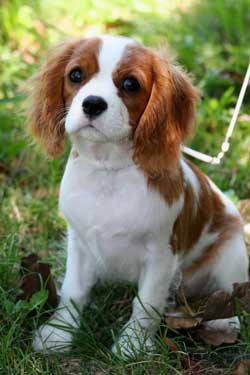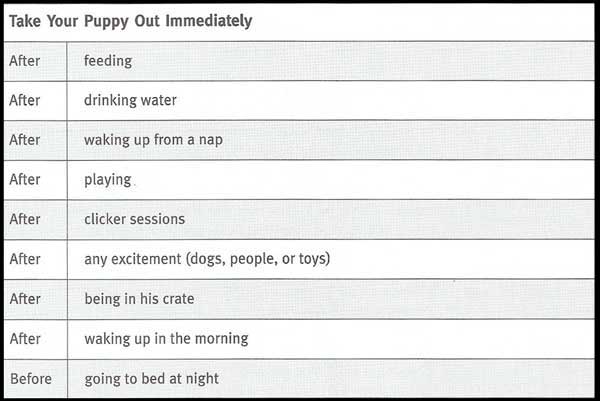Housetraining Basics
By Peggy Tillman on 01/24/2012


Filed in - Skills for Every Day
Editor's note: Experienced dog owners who are new to clicker training are often heard to say, "I wish I started clicking when my dog was a puppy." Clicker training is a powerful method of molding a puppy's attitude and capacity to learn. When a puppy knows right from the beginning that it can earn rewards—whether a treat or a chance to play with you—by paying attention and learning new behaviors, it matures into an extraordinary canine companion. Clicking will give your puppy confidence and comfort through positive experiences and clear communication. Here's how to get started housetraining the clicker way.

If your puppy came from a knowledgeable breeder, his mother may have already trained him to eliminate outside. When breeders provide a way for the mother dog to take her puppies out, the mother dog will often housetrain her puppies. However, if you're reading this, you probably have to do the housetraining yourself.
The potty spot
Your goal is to teach your puppy the right place to eliminate. The first thing you must do is choose one spot that will be his permanent bathroom: the "potty" spot. When you take your puppy out to potty, always use the same door and go to the same potty spot.
Watch your puppy carefully in the potty spot. Plan on waiting for him. Let him sniff around. When he begins going, quietly say your potty cue—a word that will tell your dog that this is the place and time to go. (Be careful in choosing your "potty" word. You will want to use this word in public. This cue will come in very handy when you're away from home.)
Click and treat just as your puppy is finishing his business. You want to click while the behavior is still happening, but not so early in the process that your puppy stops eliminating prematurely in order to get to his treat. With a bit of practice you'll quickly learn to time your click and treat so that your puppy associates his reward with eliminating in the right place—yet isn't interrupted before completion.
Soon your puppy will know that: potty in house = no reward; potty in potty spot = really great rewards!
Bell signal
A bell can be a useful tool for your dog to tell you he wants to go out. Because he can't speak to you in your language, he must use a signal to tell you he needs to go out. You must learn to recognize that signal. Put a bell on the door that leads to the potty spot. The bell rings every time someone goes in or out that door. Remember how fast a dog learns what a doorbell means? Well, your puppy will learn that the bell means that the door is opening. Many puppies will go to the bell and ring it without any special training. However, to speed up the process, take him to the bell. If he touches it, click and treat him. Then quickly open the door and run outside, praising him. If he shows no interest in touching the bell, you can rub cheese or peanut butter on it.
Crate training
It is a good idea to put the puppy in a crate at night and during the day when you can't watch him. Most puppies don't want to eliminate in their nest. If your puppy is very small and you have a large crate, divide it up so the puppy has just enough room to stand up and turn around.
Depending on the age of the puppy, you may have to get up in the middle of the night to take him out. Some people like to keep their puppy's crate in their bedroom at night, so they can easily hear when he wakes and can take him out before he eliminates in his crate. Always take your puppy out when you first get up in the morning.
Accidents
If your puppy has an accident, try not to be angry or upset (this is sometimes hard), because if he fears you it will slow his learning. This is not an instant process, but if it's done properly your dog won't fear you and he will learn what you want.
When the puppy has an accident in the house (and he will), remain as calm as possible. If you're lucky, you will catch him before he finishes. Quietly get the puppy and take him out to his potty spot. Use your potty cue, and if he goes, click and treat him. (If he doesn't eliminate, try again later. When he does go, click, make a fuss over him, and reward him with a treat or play.)
Go back into the house and use paper towels to pick up the mistake. Place the towels in the potty spot. Leave the towels there as a signal to your dog that this is the correct place for him to eliminate. Don't let the place get dirty; just leave enough to mark the spot for your puppy.
Clean up the area your puppy used by mistake with white vinegar. Vinegar will help eliminate the odor. You can also buy products at pet stores to help remove the smell. Removal of the odor is important in discouraging the puppy from using that spot again.

If you understand when your puppy needs to go out, then you can eliminate many accidents. The following suggestions will help your puppy succeed with his housetraining.
- Always watch your puppy. You can tie him to you in the house. You can confine the puppy to the room you are in with puppy gates. You can also crate train him.
- Feed on a fixed schedule. Usually he will need to go right after he has eaten.
- Always take him out after eating, playing, or any excitement. He will need to go out after exercise, after waking up, and before going to bed at night.
For more detailed information on crate training, teaching sit, down, stay, leave it, and many other key behaviors, see Clicking with Your Dog, by Peggy Tillman.

No comments:
Post a Comment